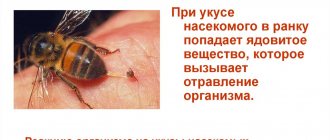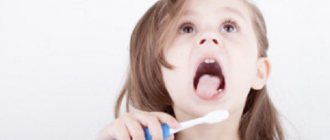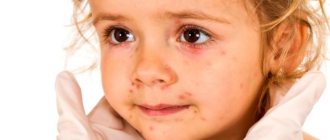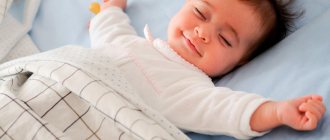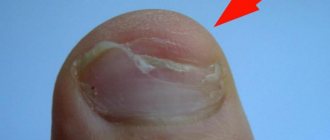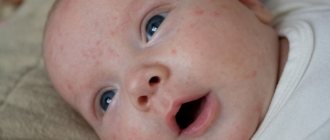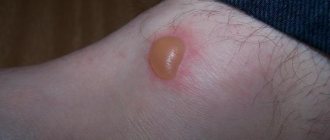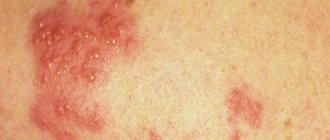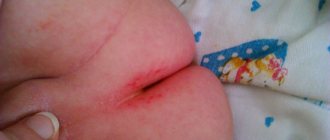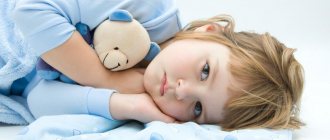From time to time, acne may appear on the child’s hands, photos of which are presented below and which parents should pay attention to, as they may indicate the presence of some contagious disease, allergic reaction or serious illness.
They can also appear upon contact with a poisonous plant, insect bites, and also due to an imbalance of internal organs. As can be seen from all of the above, there are quite a few different reasons for the formation of pimples, so you should immediately contact a pediatrician or dermatologist to identify the cause and eliminate it.
For what reasons do they appear?
Very often, parents notice small pimples on their child’s hands, which may be a symptom of some skin disease. If they appear, you should immediately go to the doctor, as they may indicate the presence of scabies, which belongs to the category of parasitic infectious diseases.
The causative agent of this disease is the scabies mite, which can quickly spread to all family members in a short time, and this disease can be identified not only by the presence of these pimples, but also by the severe itching that is observed in the places where they form.
Small pimples on a child’s hands are formed due to skin contact with any aggressive household chemicals, as well as after consuming certain medications or food containing allergens.
Often, small pimples appear on the hands of children in the form of nodules shaped like a hemisphere, in this case we are talking about the presence of molluscum contagiosum, which also requires immediate treatment. If itchy, slightly raised, flat pimples or pale pink blisters appear on a child’s hands, this may indicate the presence of hives, which is one of the symptoms of an allergy.
Causes of acne
Many diseases are accompanied by a rash on the baby’s hands during his growth period. Only a doctor can make an accurate diagnosis after a thorough examination of the baby. The most common cause of pimples is allergies. Almost every child has had an allergic rash to various foods or external factors at least once in their life. Today, skin irritation in infants due to various detergents for washing baby clothes is often encountered.
The cause of a rash in a newborn can be diaper rash or prickly heat, when there is poor air circulation in the folds of the skin. Delicate skin reacts with rashes when the weather changes, after a long walk in too hot clothes. Another common cause of pimples in newborns is dysbiosis. Simultaneously with the rash in such cases, bowel dysfunction is observed. A rash in children can appear due to chickenpox, measles and other infectious diseases.
The importance of seeing a doctor
Any skin rashes in children require professional treatment, especially in newborns. At the first signs of a skin disease, you should limit the child’s communication with other people, because acne is often caused by infection. It is very difficult to make a correct diagnosis without a doctor, and self-medication can end in failure. Watery blisters on the body could be eczema or another serious condition that needs immediate treatment.
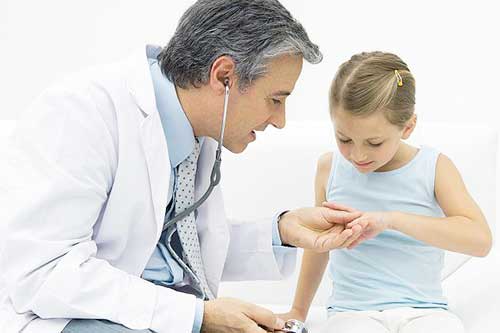
Kinds
Many people are accustomed to the fact that pimples appear anywhere, for example on the back or on the face, but not on the arms, but this is not at all true. A rash can easily form on any part of the skin of the arms, for example on the crook of the elbow or on the back of the palms, and there are a variety of types of acne that can appear on the skin of the upper extremities.
The following types of acne may form on the skin of children's hands:
- red pimples on the child’s hands that resemble spots;
- black or translucent white dots;
- purulent pimples or blisters;
- watery pimples;
- dry pimples covered with a dense membrane;
- blisters with scaly spots;
- subcutaneous pimples.
In addition, all rashes can be localized in certain places. So, for example, pimples form on the hands, palms, and sometimes on the inner bends of the elbows, which may indicate a disturbance in the activity of the sweat glands or dyshidrosis.
If pimples appear on the skin of the arms above the elbow line, they may indicate the presence of keratosis of the follicles or an allergic reaction. Rashes may appear on the fingers due to fungal infections, scabies or molluscum contagiosum.
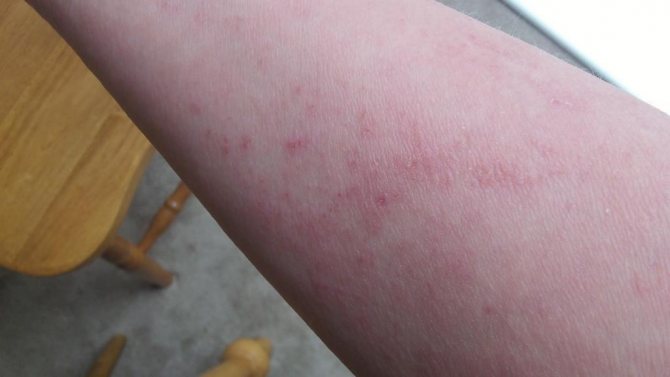
The pimples may appear in small numbers on the hands or as a large rash with or without severe itching. In addition, the rash elements can be large or very small, dot-like, transparent, white, dark or red.
In addition, watery pimples on a child’s hands can be a symptom of various diseases, while other pimples are a characteristic sign of a specific ailment. So, for example, small red or pale pink pimples that can appear on the entire surface of the skin of the hands are a symptom of mononucleosis. Small stars that resemble stars can appear on children’s hands due to such a dangerous disease as meningococcal infection.
How does it manifest?
The appearance of rashes that appear on the skin of the hands may vary. It depends on what caused the appearance of such specific changes on the skin. Infectious skin pathologies are manifested by the appearance of multiple bright red spots on the skin. This small rash usually itches a lot. Rashes can appear in a child both on the arms and on the stomach.
Staphylococcal flora causes the appearance of multiple blisters on the baby’s skin, filled from the inside with serous or yellow liquid. The severe course of the disease is accompanied by the appearance of pus in such rashes. These skin blisters may burst when touched.
A fungal infection occurs in a child with the development of multiple white rashes. In some cases, they may also have a yellowish tint. Usually the surface of fungal rashes is uneven. On the outside, such skin elements are covered with a large number of easily exfoliated skin scales. In some cases, the rash may not be intensely colored and may be colorless.
Allergic skin changes that occur on the hands and cheeks are manifested by the appearance of bright red or crimson spots. This localization is quite common in infants who are beginning to receive their first complementary foods for the first time in their lives. In this case, some food products become allergens. Quite often, various fruit or vegetable purees that are orange or yellow in color lead to the development of allergies in children.
Large red spots on the hands and arms may be a manifestation of prickly heat. This symptom manifests itself especially clearly in babies in the first months of life. Such “flaming” spots appear in places of direct contact with clothing. The affected areas may also feel warm and moist to the touch.
Acne appeared on the child's hands
Acne on the hands can occur due to various reasons. It can be:
- repeated allergic reaction to medications;
- bacterial or infectious disease;
- hereditary disease;
- failure to observe basic personal hygiene (the result of bacterial growth due to infection entering the body).
Another cause of acne on the legs and arms of a child may be a sudden hormonal change. Most often this occurs during adolescence. Most teenagers suffer from acne and mostly only the face is treated, while, for example, the hands are left and this problem is avoided. This is incorrect, since it is better to treat these rashes so that there are no complications. You should not squeeze out pimples yourself. This will likely cause more infection of the skin tissue, especially if done with unwashed hands, and may also leave scars or welts.
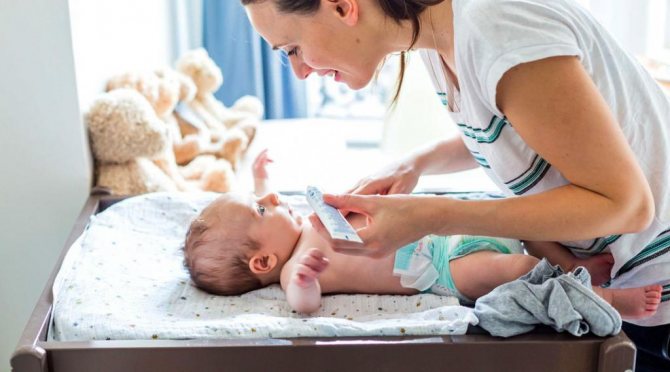
To completely solve this problem, you should review all your cosmetics. It is best to choose products made from natural ingredients. It’s even better if the cosmetics are from the same company. Before using any medication, be it ointment, gel, tablets or cream, you should consult a pediatrician. This applies not only to children, but also to girls and boys in adolescence.
The most effective means of combating white pimples on a child’s hands are given below:
- Boric acid is good for treating acne on the arms and legs after insect bites. To do this, you need to soak a cotton swab in a solution of boric alcohol. It is necessary to wipe the affected part of the body overnight and leave air access to it. You can achieve a faster effect if you also wipe it in the morning, but in this case there is a risk of drying out the skin. The effect will likely be visible within a week.
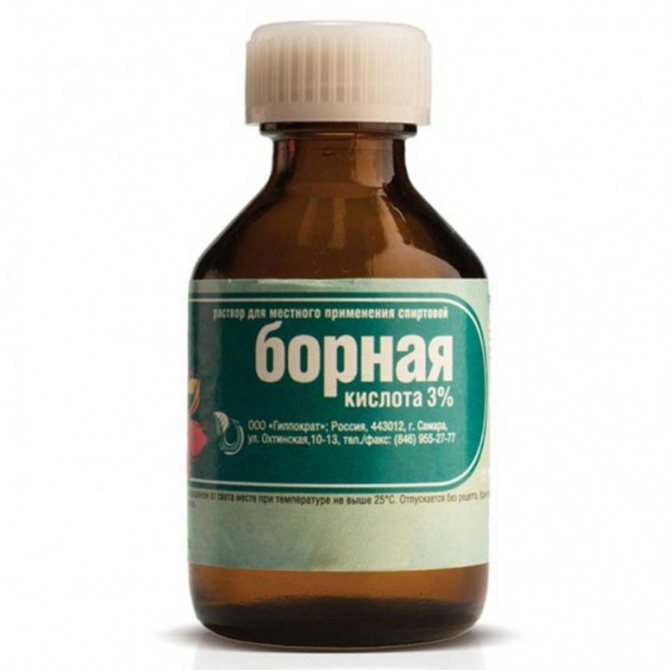
- Antihistamine tablets for acne are quite effective drugs aimed at eliminating the manifestations of allergies on the skin.
- Probiotics. Such drugs actively affect the root cause of formations inside the skin. Some of the most popular products at the moment are “Bifiform” and “Lactofiltrum”.
- Hormonal drugs. There are medications that regulate hormonal balance due to hormonal imbalance. This most often occurs in children over 10 years of age. Medicines can radically change the situation, because there will no longer be any reason for acne to occur.
What to do if you itch
If a rash is causing discomfort to a child, adults should be careful to ensure that the child does not scratch the pimples. The only thing that can be done to help the baby before the pediatrician prescribes the correct treatment is to wipe the affected areas of the skin with cool filtered water as often as possible. This will help temporarily reduce itching, relieve swelling, and prevent your child from scratching.
Young parents mistakenly ignore small pimples in children, most often appearing on the arms and legs. Such a rash may be a symptom of a serious illness that requires prompt medical attention. To avoid complications, adults are not recommended to self-medicate their child, but to immediately contact a qualified pediatrician.
Article design: Vladimir the Great
Ointments and other drugs
What medications and antibiotic ointments are used for acne on the legs and arms of a child? Let's list the main ones:
- "Erythromycin".
- "Dalacin."
- "Clindamycin."
- "Lactofiltrum" is taken in tablets, but it is contraindicated in case of digestive disorders.
- “Zinerit”, which can dry out skin rashes not only on the hands, but also on other parts of the body.
- Antibacterial agents such as benzene peroxide. This drug has a strong property of dissolving skin deposits. The medication has no contraindications, but during pregnancy it can be used only on the recommendation of the attending physician.
- Acids. Quite strong drugs that are mostly used in cosmetology because they have a very wide range of applications. They are also used to remove dead dermal cells. Acids have a positive effect on the functioning of the glands. It is worth noting that they do not cause addiction to the entire body, so they can be used for a long time. On average, results are visible after 2-3 weeks of treatment.
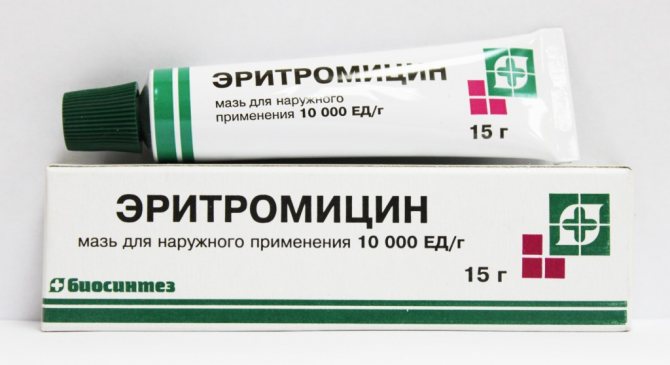
Types of rashes in children
There is a separate classification of pathology based on the nature (appearance) of acne. The photo with explanations clearly shows the visual differences between each type of rash.
Types of baby rash:
- Tubercles.
- Blisters. Characteristic of allergies and insect bites.
- Papules. Red formations. They usually appear during inflammatory processes or due to damage by various viruses.
- Bubbles. Filled with clear or cloudy fluid of serous origin.
- Pustules (ulcers). Filled with purulent exudate and usually leave small scars after complete healing.
- Stains. They cannot be felt; they do not rise above the surface of the dermis. The spots are usually white or red.
On the head, face and neck
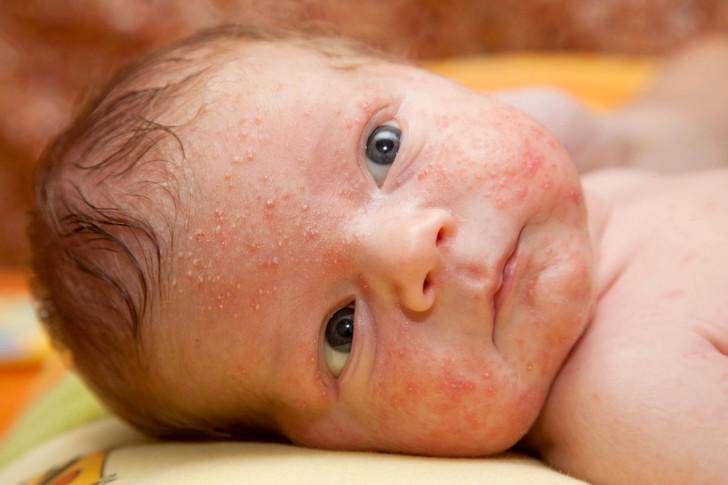
The head, face and neck can be “sprinkled” for several reasons:
- food or contact allergies (we recommend reading: food allergies in children: photo of the rash);
- irritation (inappropriate care products or excess saliva during teething provoke a rash around the mouth, chin or neck);
- insufficient hygiene, overheating (prickly heat appears);
- infectious diseases (chickenpox, rubella, measles);
- disturbance in the functioning of internal organs;
- intoxication;
- perinatal rash (facial acne in newborns).
On the body
A rash that covers the entire body or most of it is a cause of serious concern (see also: rash all over the body in a newborn baby). In this case, red blisters or blisters may indicate an infectious disease, such as chickenpox, enterovirus, or a large-scale allergic reaction (atopic dermatitis, urticaria).
READ ALSO: How to understand what caused a rash in a child?
It is necessary to immediately contact a pediatrician and monitor the child’s condition – body temperature, general health, presence of stomach upset or nausea. Sometimes the problem appears when there is a serious malfunction of the body as a response from defense mechanisms. This will require a comprehensive examination and proper treatment of the root cause.
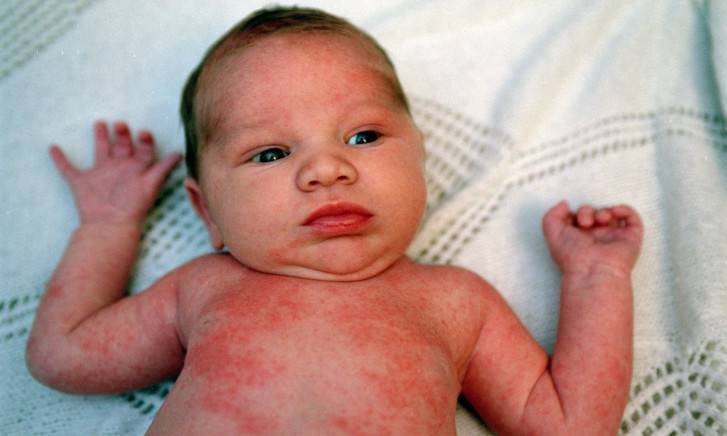
On the legs and arms
Rashes on the arms and legs can be infectious (viral or fungal), allergic, or domestic in nature. They appear as a result of insufficient or excessive hygiene, inappropriate care products, and even with ARVI or flu (individual reaction of the body).
Main reasons:
- allergies (urticaria, atopic and contact dermatitis, eczema, neurodermatitis);
- inappropriate care cosmetics;
- fungal infection (usually affects the feet);
- scabies (papules or vesicles appear) (we recommend reading: first signs, symptoms, photos and treatment of scabies in children);
- deficiency of vitamins and essential microelements;
- prickly heat;
- household factors (dry air, indoor heat);
- insect bites;
- hypothermia or exposure to direct sunlight;
- infection (chickenpox, measles, rubella, scarlet fever);
- ringworm (we recommend reading: ringworm in a child: symptoms and treatment);
- psoriasis.
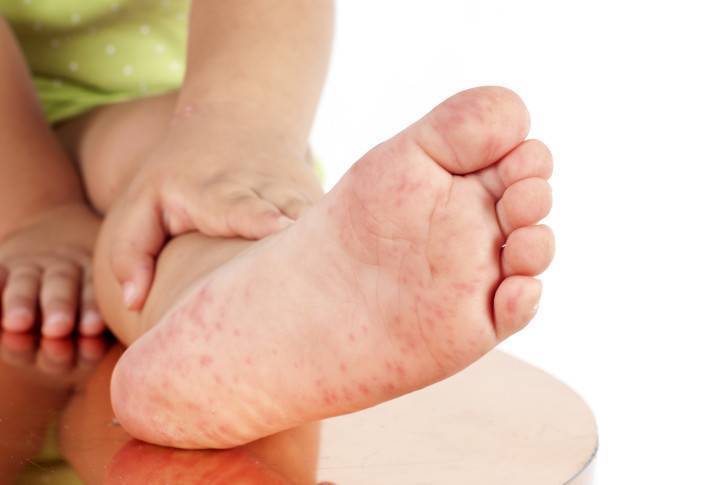
On the stomach and chest
A rash on the stomach of a child is a common occurrence. Having noticed it, you need to contact your pediatrician, since it is very difficult or impossible to independently determine the cause of its appearance. Most often, a rash on the stomach and chest occurs for the following reasons:
- Allergic reaction. An allergy to the stomach in a child can be a reaction to foods, medications, pets, clothing and bedding (the material contains synthetics).
- Dermatological problems. Various types of dermatitis appear due to pathologies in one or more layers of the dermis.
- Hygiene factor. Miliaria in the lower abdomen and groin is typical for one-year-old children. Irregular bathing and dirty clothes of the baby also provoke the problem.
- Infection. Infectious diseases can initially affect the chest and abdomen and then spread throughout the body. The herpes virus in childhood is localized precisely on the stomach.
On the back and lower back
Pimples on the back are usually infectious or allergic in nature (to foods, medications). Many contagious sores gradually spread to the surface of the back (spine area), covering the entire body. Small pimples on the back and shoulders can appear at sea as a reaction to the sun and salt.
Rash on the lower back and buttocks in babies is even more common than on the face (we recommend reading: treatment of diaper rash on the buttocks in newborns). In half of the cases it is provoked by household factors, in the rest - by allergies.
READ ALSO: how red pimples on a child’s bottom are treated and photos
Delicate and thin skin reacts to diapers, hygiene products, overheating (this area overheats especially often) or, conversely, hypothermia.
Gels
If acne on a child’s hands itches, the following medications are used:
- "Baziron gel". The product is applied directly to acne, but has some side effects, so before use you need to read the instructions for use and consult with a specialist.
- "Metrogil gel" helps with whiteheads affecting the body.
- "Levomycelin". Wipe the skin twice a day with a cotton swab soaked in the solution.
- "Tsindol" is a powerful remedy, but before using it, it is worth testing it on a small area of the skin, due to the fact that it can cause an additional allergic reaction.
In the most severe cases, drugs based on tazarotene and adapolene can help. In many situations, laser treatment can be used. The laser beam penetrates deep into the skin and can destroy the most serious foci of contamination almost painlessly. The beam affects the affected tissues without causing any harm to health at all, so the procedure is harmless to the patient. When the beam hits the site of inflammation, the temperature rises and the bacteria die. Thus, this procedure simultaneously stops and destroys even the most serious formations.
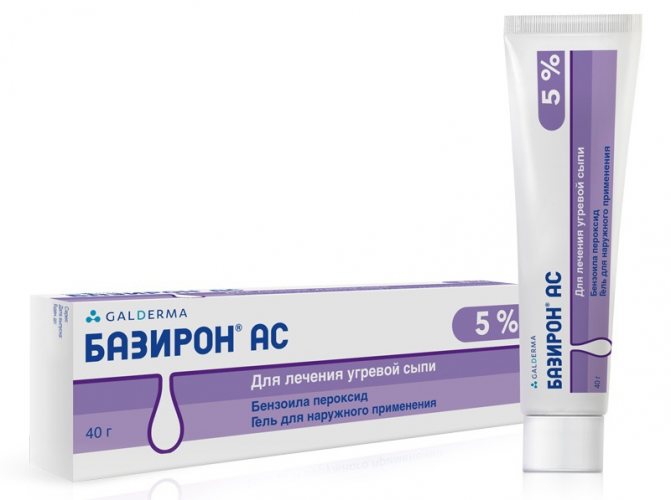
The spot application of antiseptics also helps very well, especially for acne caused by disruption of the sebaceous glands.
In the end, of course, it is important to follow basic hygiene rules. You should wash your hands more often if they get dirty quickly and often. Diets can improve the situation. Often the appearance of a rash is due to poor nutrition. In this case, you should reconsider your diet. Fatty, salty and spicy foods should be excluded from it. A large proportion of the diet should contain fresh fruits and vegetables, cereals and salads.
Pimples on the palms of a child
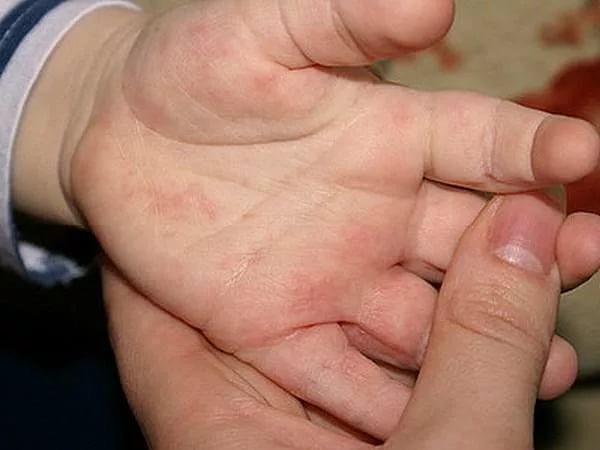
The causes of acne in children are the same as in adults. But the child’s body is less resistant to the effects of negative agents. At the first manifestations, you should consult a pediatrician.
The younger the child, the less developed his internal systems are. Not paying attention to symptoms, untimely or inadequate treatment can greatly aggravate the problem.
The main factors contributing to the formation of pimples on the hands of children are:
- Allergic reaction. Kids get acquainted with the outside world; a rash can be the result of the introduction of new products or contact with plants. Pimples are localized on the surface of the palms and fingers.
- Infectious diseases. With ARVI, chickenpox, measles and other pathologies of infectious origin, an increase in temperature and increased sweating are observed. With hypersecretion of the sweat glands, small pimples are formed on the inside of the hand.
- Enterovirus infection, dysbacteriosis. An increase in pathogenic flora in the intestines is accompanied by a skin rash.
- Dermatitis . Improper skin care, excessive wrapping, and heredity are the main factors in the development of skin pathologies accompanied by rashes.
The presence of additional clinical signs: redness, suppuration, child complaints that the hands are starting to itch, indicates progression of the disease.
Traditional treatment
The medicinal industry provides a considerable selection of drugs to get rid of acne: special bactericidal lotions and shower products. Lotions should be applied directly to those areas where there are rashes. But scrubs can be used no more than twice a week.
After cleansing and water procedures, anti-inflammatory creams and gels should be applied to the skin. You can use well-known folk methods to get rid of rashes. Herbs have a wonderful effect. You can make lotions and baths with a decoction of plants. Eliminate scented soap from your care products, replacing it with tar soap. This soap perfectly disinfects and makes the skin drier, controls the process of the sebaceous glands. Here are some effective folk methods of treatment.
Treatment of acne on the palms
A doctor should identify the cause and treat rashes on the inside of the hands. Different diseases may have similar clinical manifestations, and an incorrect diagnosis and inappropriate treatment can lead to complications.
Therapy is prescribed individually and includes a set of procedures and courses of medications. During treatment, it is necessary to follow the doctor’s recommendations exactly and report any deterioration. Traditional medicine has proven itself well, but the use of home remedies should be agreed with a doctor.
Drug therapy
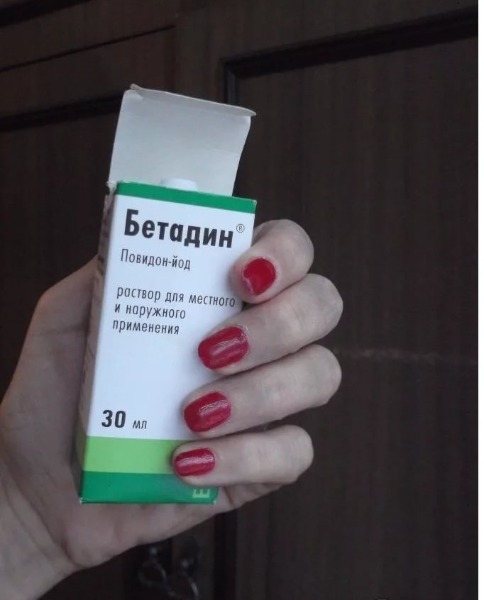
Pharmacotherapy is aimed at eliminating the cause, relieving symptoms and preventing relapses.
Depending on the pathology that caused the pimples on the palms and the severity, the doctor may prescribe the following medications:
- regenerants and reparants kill pathogenic flora, prevent infectious and inflammatory complications: Depanthenol, Chlorhexidine;
- antiseptics have antifungal and antibacterial effects: Citeal; Betadine;
- water-electrolyte balance regulators relieve inflammation, increase the protective functions of the skin: Dimephosphone;
- anti-allergenic agents: Videstem;
- antiviral drugs: Interferon.
In some cases, antibiotics are required.
Folk remedies
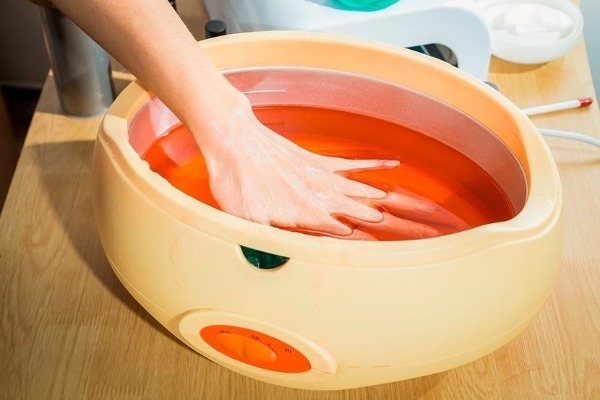
Alternative medicine offers a number of effective remedies for eliminating pimples on the palms:
- Treatment of the affected epidermis with calendula tincture. Moisten a swab or cotton pad with the product and wipe your hands twice a day.
- Baths with herbs. Mix according to Art. l. chamomile, marigold flowers, St. John's wort and pour 200 ml of boiling water, leave for half an hour, filter. The solution is added to warm water and hands are kept in it for 15 minutes. The procedure is repeated daily.
- Aloe lotions. A piece of gauze or bandage is moistened in the juice of the plant, applied to the palms and wrapped in cling film. After 20 minutes, the lotion is removed and hands are washed with water.
Be sure to read:
Pimple under the armpit: causes, what to do if it hurts, how to treat internal ones
The products can be used to prevent rashes and improve skin condition.
Potato lotion
Grate the potatoes and apply a gauze compress to the inflamed area. You can also arrange a bath with potato starch: at the rate of 1 kilogram of starch per whole bath. The procedure will undoubtedly help relieve itching and dry out the pustules.
It’s easier to prevent any health problem than to go to the doctors later. Taking into account the fact that there are quite a large number of causes of acne, adhere to preventive prescriptions.
If pimples cause quite severe discomfort - they itch and get wet, then all sorts of attempts at self-medication have a good chance of ending in aggravation. Therefore, to avoid unfortunate results, be sure to seek support from a qualified professional.
Need for medical attention
Small pimples on the hands in most cases appear in small numbers and go away on their own after a certain time.
A person requires medical assistance if:
- rashes on the body quickly increase and merge with each other;
- there is severe itching and discomfort;
- small pimples appeared on all family members;
- rashes contain pus and blood;
- accompanying symptoms appeared in the form of severe swelling and inflammation.
A doctor should be consulted if a person has been in contact with shellfish. The same applies to rashes that are easily damaged and bleeding wounds form in their place. High temperature should also be a concern. You need to contact a dermatologist and start treatment.
Lemon
Lemon juice works very well against subcutaneous acne on the hands. Half the fruit is squeezed out and dissolved in 200 grams of water. The ingredients are mixed. The finished mixture is suitable for fighting inflammation. When using this method, the surface of the hands is cleaned and harmful bacteria are destroyed.
Inflammations gradually disappear, and the skin of the hands becomes healthy. This product should be used once a day. Leave diluted lemon juice on the skin for 5 to 10 minutes. There is a possibility of burning during the procedure. At the end of the session, the lemon juice is washed off with warm water.
Skin pathologies
The first thing every dermatologist will suspect when he hears a complaint about pimples is scabies. On the skin of the palms, this disease manifests itself as a small reddish rash, and under the upper layers of the epidermis, grayish stripes are noticeable - the passages of the scabies mite. The parasite most often penetrates the skin between the fingers, since it is in this place that it is very tender.
Among the skin diseases that occur with rashes on the skin of the palms, it is worth noting fungus. It usually affects the nail plate, but in advanced cases it can spread to the hands. Both scabies and fungus are contagious diseases, so tactile contact with people suffering from these diseases should be avoided.
